Storing and Organizing Food Aboard – You Can Beat Heat, Moisture and Motion!
With some care and small modifications, groceries can find their perfect spot aboard and will not end up smashed, rotten, or leaking.
How am I going to feed everyone with this tiny fridge? Where do I put all this stuff? Can I even buy food in glass jars? Are the eggs OK to leave out? Where do I start?
Think shade, good ventilation and hanging bags!
We have managed it with three teens, living on a cat and a mono, for four years, and I am happy to share how.
Also, check out my page full of useful items: The Boat Gear Page
Always keep in mind – Heat, Moisture and Motion
So, you brought all your groceries aboard, and nothing fell in the water – good! Now what?
Handling Heat
Ideally, there will be some refrigeration aboard. We did meet a family, who lived on a boat for two years, with no refrigeration! I was baffled and in awe at that mom’s resilience and knowledge!
Now, for those of us who like to hold on to some land conveniences – have a fridge (and a freezer).
The smaller-the better. A small refrigerator is a blessing in the galley – nothing will be lost and rotten in the back.
And it means frequent trips to shore – any walk and time spent outside is welcome, with kids and teens aboard.
Speaking of frequent trips – here is a post on selecting the most comfortable shoes:
Comfortable Sailing Shoes for Every Boating Need
Keeping the hatches open and allowing for good airflow will help with the heat. If you are at a marina and with access to air-conditioning, handling the heat is much easier.
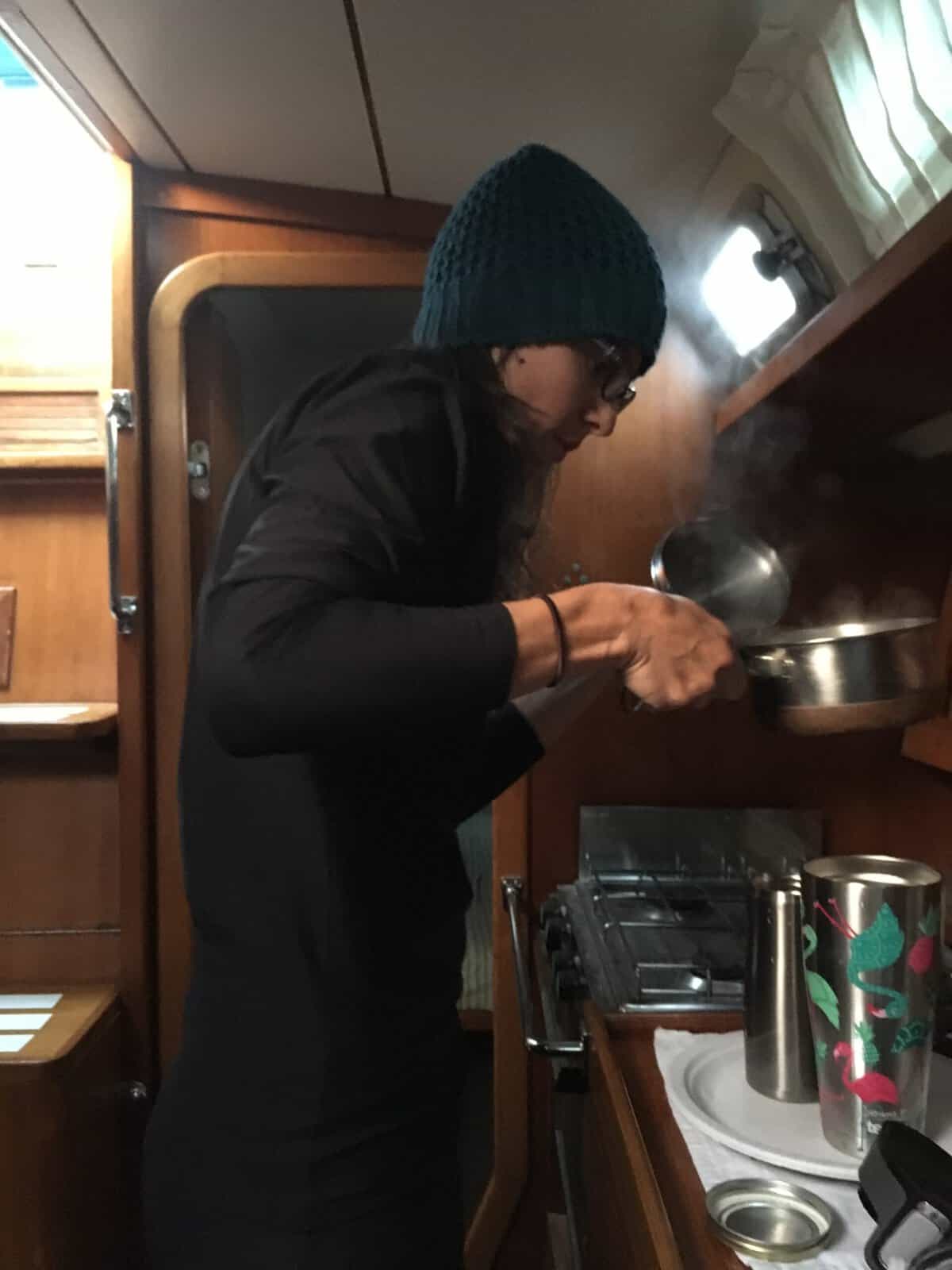
Tip: For everything, which does not need to be stored in a refrigerator (most of the groceries, actually), find a spot, which is continuously in the shade – cabinets, bilges, lockers, and so on.
Battling Moisture
Soggy chips, moldy bread, sticky sugar and spices, anyone?
Moisture is a given, when living aboard, there is no way around it, even with a dehumidifier running.
Once at anchor, however, the salty moist air fills our lungs and helps with seasonal allergies, but also created an environment of perpetually frizzy hair, damp sheets and soft crackers.
All of usual methods of keeping foods will work aboard – airtight containers, Ziplock bags, as well as clothes pins to secure the roll-closed plastic bag.
Avoid opening the packages frequently.
If you open a large bag of pretzels, pour it all out into a large airtight container and take out small portions in Ziplock bags, or a smaller airtight serving container.
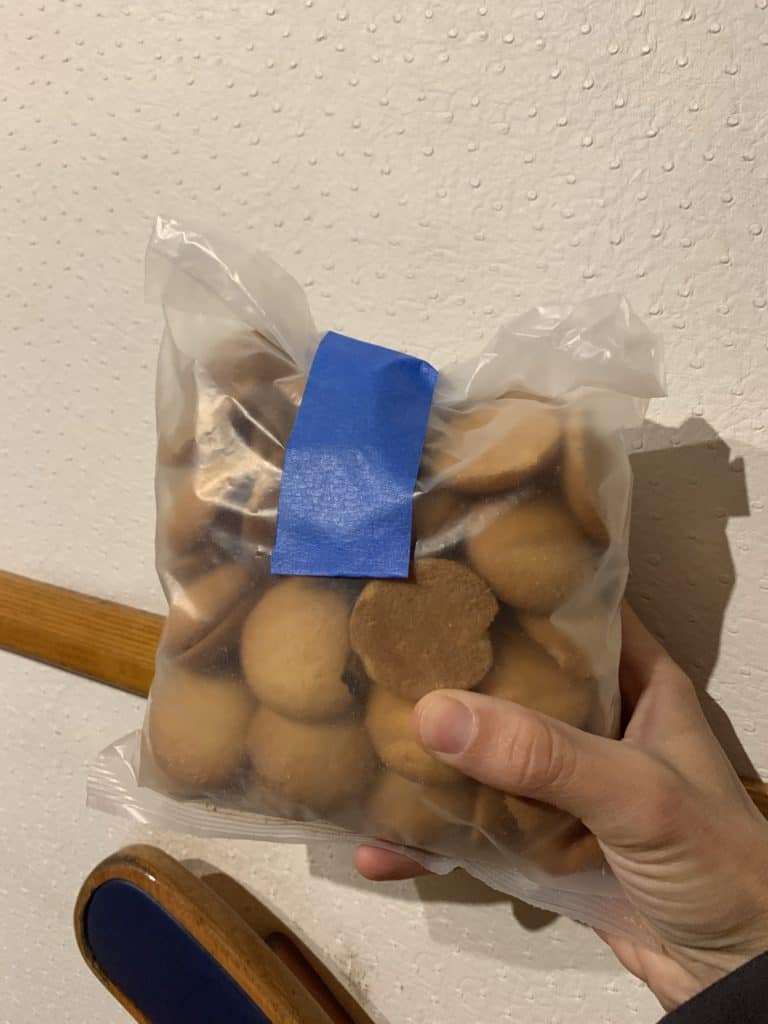
Tip: Best tip against soggy foods and snacks aboard, however, is timely consumption. A few small packages of chips can be an occasional treat aboard, and will help beat the bad habit of frequent junk food snacking!
Going with the flow of Motion
Storing groceries aboard is done utilizing every space available. You must also consider the passages with the possibility of things rolling, crushing, breaking and flying.
We have stored supplies on a monohull, as well as on a catamaran – nothing ever leaked, or broke.
Let me rekindle that fire: Catamaran vs Monohull: Let’s Solve This Thing!
When storing stacked containers, you can place them behind clothes bins, or other items, to cushion them and prevent from rolling and falling.
Bilges are excellent storing sites, because they are low in the floor, and if something does spill, it can be cleaned easily.
All tropical fruits can be stored well in hammocks and hanging mesh bags (to allow plenty of ventilation).
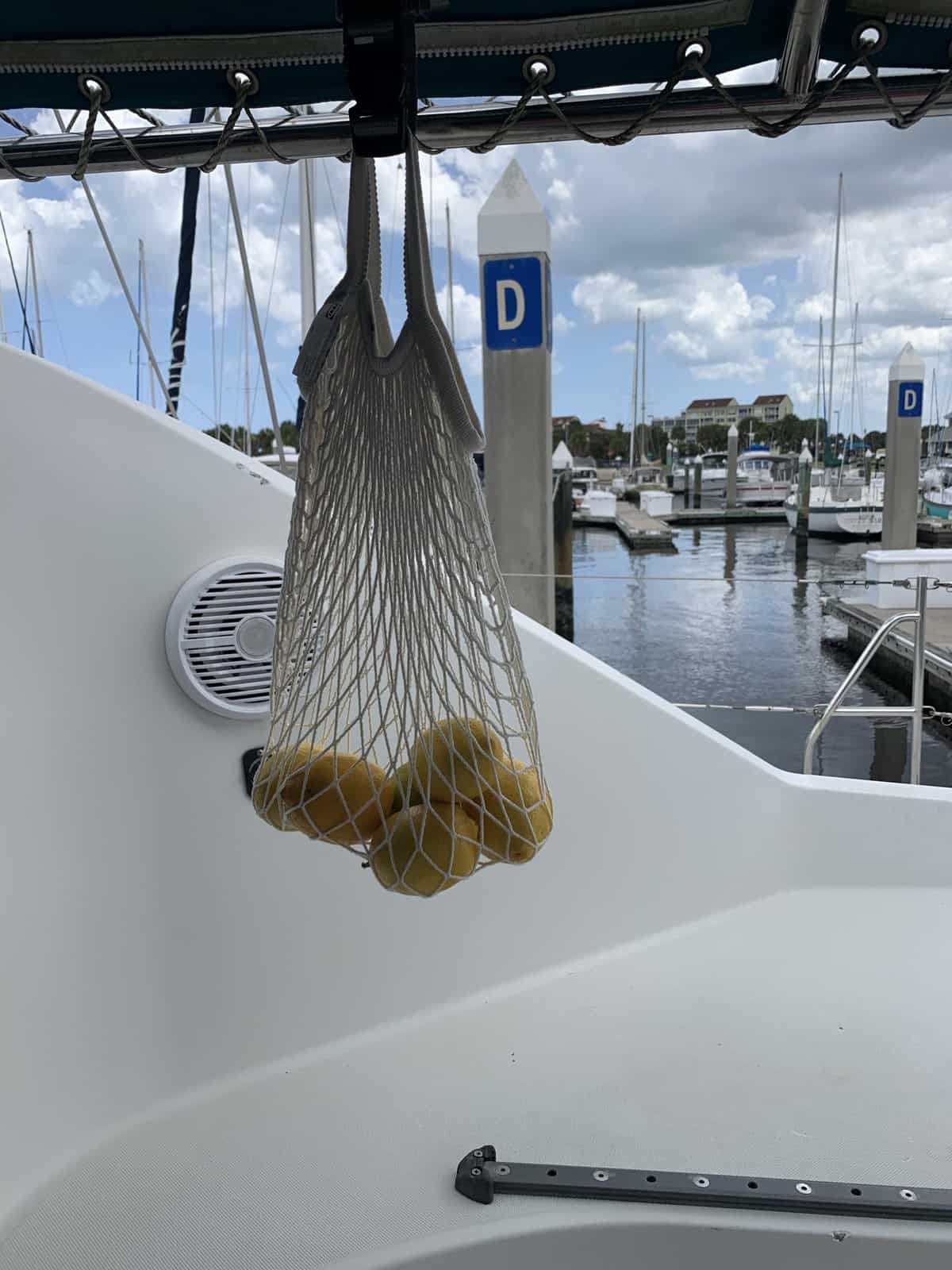
Tip: If storing fruits in a hanging bag, swing it around, to test what it might potentially hit, while the boat is in motion. We did end up with bananas that smashed against the mast, during a passage, and I was too seasick to check on them.
Avoid extra passengers!
Ideally, only the invited crew and friends should be aboard at any given time.
Any critters, rodents and flies have no place aboard. It is always best to try and avoid an infestation in the first place.
Dealing with such problem can be a total nightmare. We have seen it, when our beautiful large motor yacht next door, had to be hauled out, wrapped and “smoked”!
Tip: Never leave behind any food (canned food is OK), if you plan to leave and store the boat for a while.
Avoid cockroaches!
Remove ALL paper packaging and cardboard from food items.
In fact, we purchased our pasta in plastic bags, because of the risk of transporting roach eggs in cardboard boxes.
I also generally cannot stand plastic bags, here is a post all about bag:
19 Best Boating Bags. Tips How to Use Them.
Remove all loose labels (such as around metal cans) and label the tops with a sharpie.

Avoid mice and rats!
Mice and rats can climb aboard, sneak into tiny cracks and holes and create a disaster!
The cure rodents climb using the lines attached to the docks. Being at anchor solves that problem. Staying at a marina, or at a boat yard for a bit, especially if there is no one on the boat, can be a recipe for infestation.
As with any such problem, it is always best to prevent, rather than fix.
Speaking of fixing: 27 Important Tools for Boaters. Our Captain’s Favorite Toys.
There are the so called “rat guards”, which can be attached to the lines and create a barrier that the mouse cannot climb over. They look like discs and are often metal, or smooth plastic.
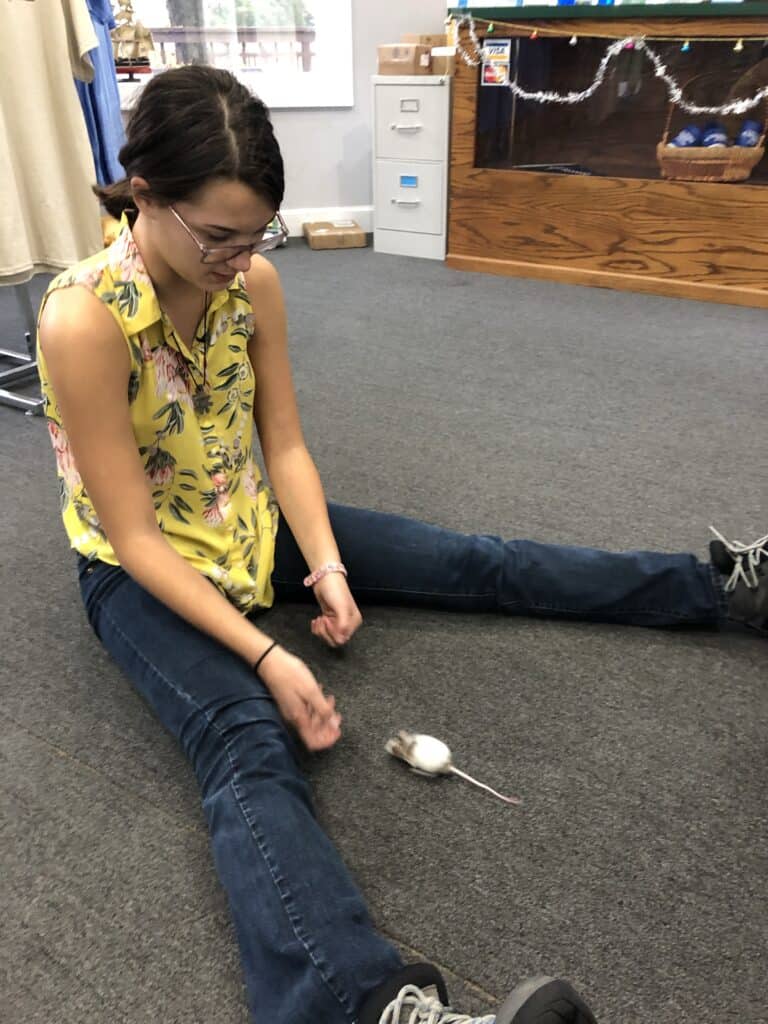
Tip: Cut a 1.5L plastic bottle in half, and thread the line through the drinking opening. Then secure to the line with the cut end facing the docks, so that mice cannot climb past that and onto your boat.
Crawling and flying friends
Buying grains of any kind, in the tropics, guarantees there will be eggs inside.
It is just a fact of sailing life we have gotten used to. Even grains purchased in the much cleaner US stores, will surprise us with a flying creature after some time.
The best tip I have against these, is to buy small packages and consume the grains quickly.
In Bulgaria, my dad shoots CO2 into plastic bottles, where we store dried beans for the whole year. This is an excellent solution, but it takes more time and supplies.
We have never done anything so drastic aboard and always cooked our grains fully.
Storing containers, including glass.
What containers work best to store food – almost all of them. Below are my recommendations, based on a few rotten, broken and rusty mistakes.
Avoid them – read on.
Stack canned food and check for rust.
Easy – stack them up to the side of cabinets and in lockers. Keep in mind that if you store them in any place prone to water leaking (such as outside lockers), they will rust quickly.
If you find a few rusty spots on cans, more like superficial rust, these should still be OK to open and consume. Heavier rust coverage is best not brushed aside, just discard the can.
Even if not visible, there might be microscopic holes on the can, which can present a perfect entry for bacteria.
We, sadly, did end up throwing out a bunch of corn and chicken, even though they smelled perfectly fine. But we had left them in an outside locker, which somehow let water inside – perfect breeding grounds for rust.
Store glass in socks.
Buy a large package of cotton crew socks (the longer the better). Then slip your glass containers and jars inside. If storing just one larger jar, twist the sock and then fold over, for extra cushioning.
We rarely wore socks aboard: 9 Sailing Outfits for any Season and Reason
At the end of the adventure you will end up with new socks, not a bad deal.

Do Not Store Paper and Cardboard.
All paper and cardboard packages must be removed and discarded. We take them off, before we put the groceries away.
Having said that, I kept flour packages in double Ziplock bags. I would sometimes insert a small silica bag as well, if the contents are prone to absorbing moisture.
I have also used the, otherwise useless, microwave aboard, to store grains.
The useless microwave is a perfect faraday cage for boating gadgets, during storms.
Tips to Keep Food Fresh
How will everything last in this hot and humid climate? I mean, will meat go bad, can you store ice-cream aboard?
Grains pair well with silica packs.
We place all of our grains in Ziplock bags, even if the packaging is bagged already. Once opened, I transfer to an airtight container.
Airtight containers that stack, work well in tall cabinet spaces. We bought ours from Walmart.
Depending on the grains, I sometimes add a package of silica bags for an extra dry environment. I bought a bag of these on Amazon and we use them in food containers, electronics containers, my guitar – everywhere.
Fruits grow and stay outside
Hanging bags work great to store tropical fruits.
As a rule, we tried to only purchase local fruits and vegetables, which eliminated the need to buy over-priced apples in the Bahamas, for example.
Most fresh fruits and vegetables are fine to keep outside of the fridge, as long as they are in a well-ventilated area and are consumed quickly.
After all, they come from non-refrigerated trees!
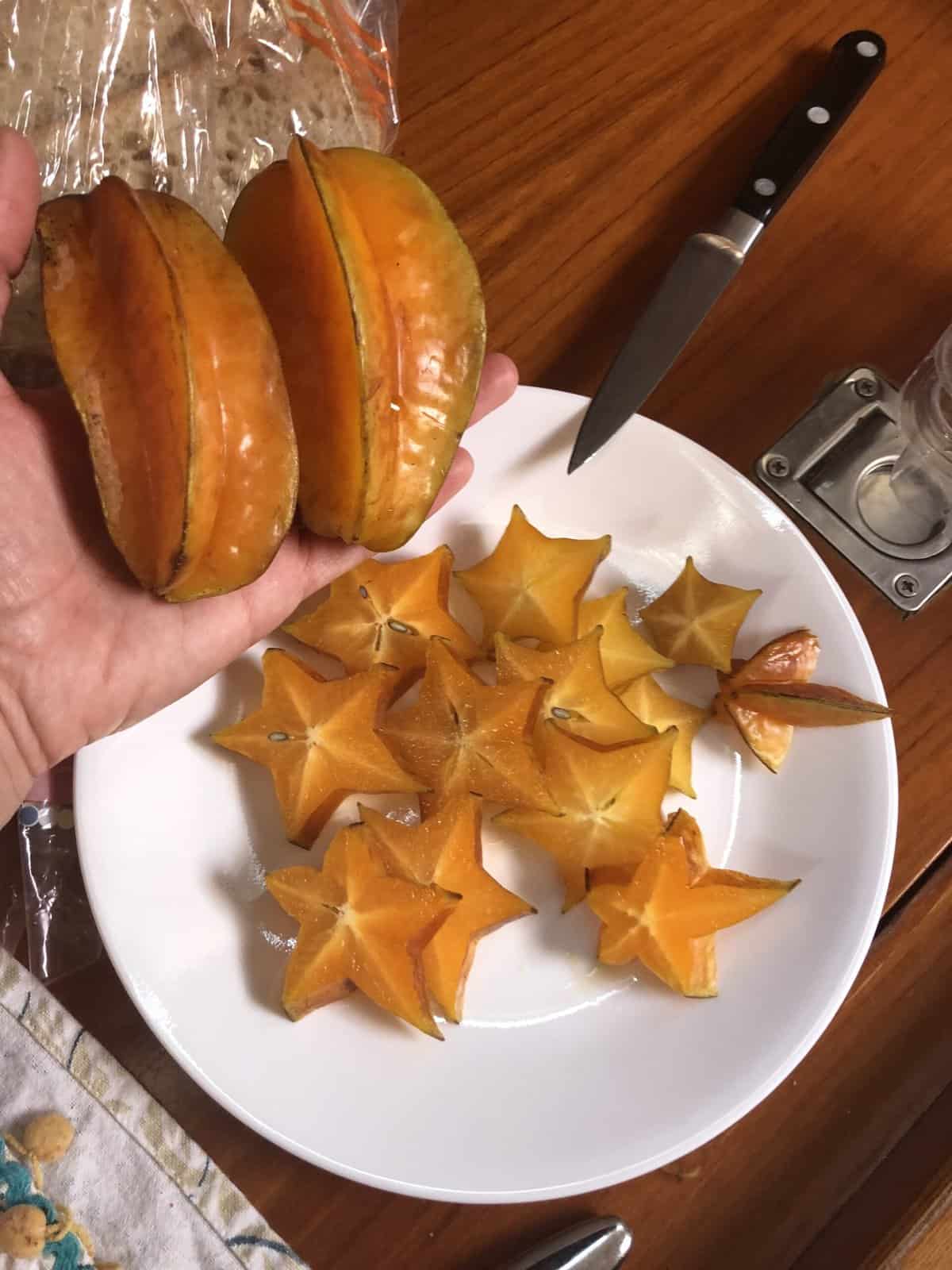
Eggs do not need a fridge.
Eggs are easily available at any of the islands we visited. We store eggs at room temperature. Previously refrigerated eggs are also fine to store at room temperature.
Make sure no eggs are cracked, and when you use them, crack them one at a time in a small cup, before transferring to the mixing bowl/pan.
Always cook your eggs fully.
I store the eggs in a plastic travel storage container right on the counter.
If your eggs came in a paper container, remember to throw it out. The plastic containers can be put away during passages if on a monohull. I leave them out on our catamaran.
Tip – A small strip of rubber cabinet liner prevents anything on the counter from sliding.
Cheese in the freezer, milk in the fridge.
Cheese is kind of expensive, but we like it, so we buy it.
We grate all of our cheese and store in the freezer, for an easy sprinkle on pizza and sandwiches.
I hate powdered milk and have never used it.
But we all love yoghurt, and I have made it many times aboard:
How to make yoghurt, with a story!
You can buy milk, and milk alternatives, in shelf-stable boxes and store them in cabinets and lockers inside the boat. They keep really well; we have never had a bad box of milk aboard.
While on the boat, however, we drastically reduced our consumption of milk – it was too hot for it. We mostly drank water and watered-down juice.
Eat meat quickly.
We have successfully stored canned chicken outside, in lockers, for over a year! The temperature never rose too high, even though we were in a tropical climate.
I am not worried about buying meat from the local butcher.
As long as the meat is fresh and does not smell bad, I consider it safe. I also cook it thoroughly – no one is eating medium-rare aboard, unless we caught it ourselves!

Chocolate and candy, anyone?
Chocolate must be stored in the fridge, alas.
Candy must also be in a cool place aboard, because discovering a melted mess inside the socks drawer is not fun at all.
We all love both chocolates and candy, so we stocked up every once in a while. But we barely had any during our touring of the Bahamas and we did just fine.
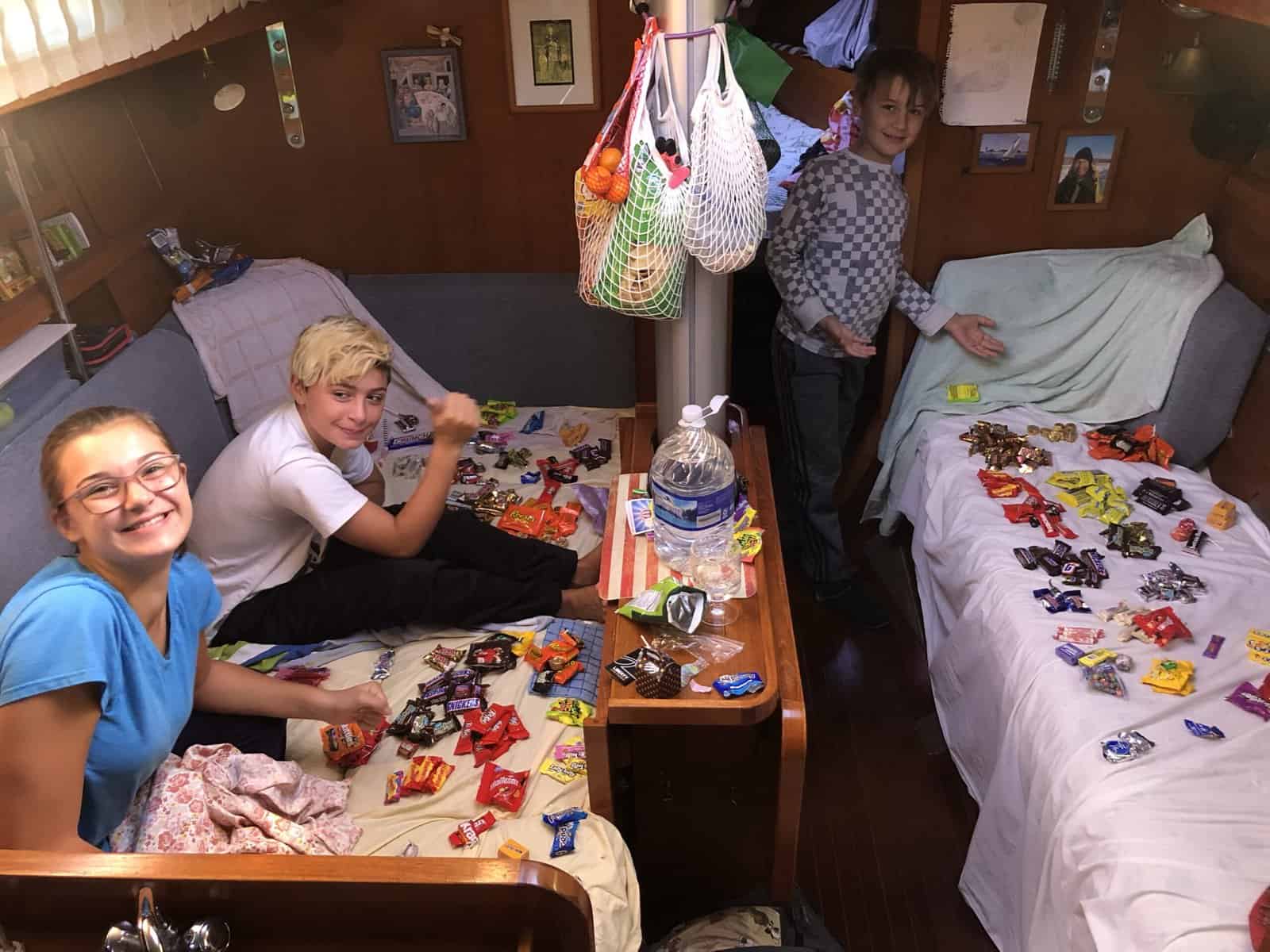
Can you guess how kids visit other boats for Halloween? On the dinghy!
We love space-taking snacks.
Snacks lived on the shelves, in the kids’ cabins.
They are probably the hardest thing to store aboard, because they are expensive, take up tons of space, and are gone in a blink!
Snacks are a must during passages, when everyone is seasick. Small bites of salty tortilla chips and pretzels can truly make a difference.
For excellent tips: Seasickness Sucks – 21 Tried and Tested Tips to Stop it.
And this one: 10 Seasickness Questions – Answered (by a Boat-mom).
Snack bags can easily be hung from everywhere you can think of. They are light and will not be crushed by rocking back and forth.
Home-baked bread never makes it to storage.
Storing bread aboard is rarely a problem, if you eat bread. We eat it fairly quickly.
Sadly, all the packaged bread we found in island countries has been the low quality sandwich bread. It lasts forever, so you rarely have to worry about proper storage.
Home-baked bread tastes much better and is not hard to bake aboard. The only drawback to that is the heat generated by the oven delivers an extra summer.
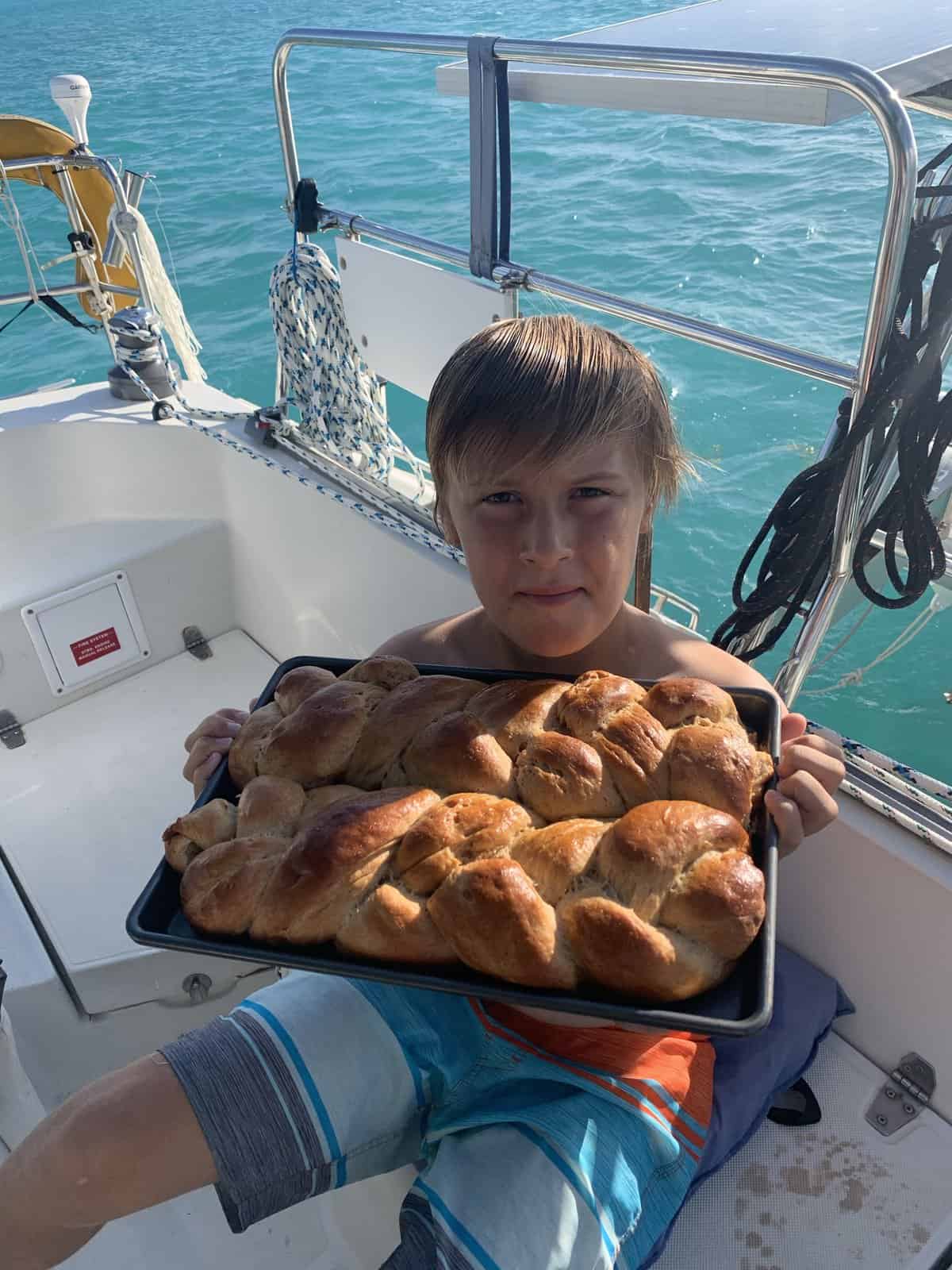
Some friends of ours had solar ovens aboard, and loved them. I tried one a few times and it never worked for me.
Drinks and bottles can also live aboard.
If possible, purchase all drinks in metal cans. Storing glass bottles can be easily achieved by sliding them into those socks I showed you earlier.
We do like red wine and especially a certain variety of boxed red wine. We threw out the boxes, except one, which turned into the designated serving container.
The bagged wine can be stored in bilges and cabinets.
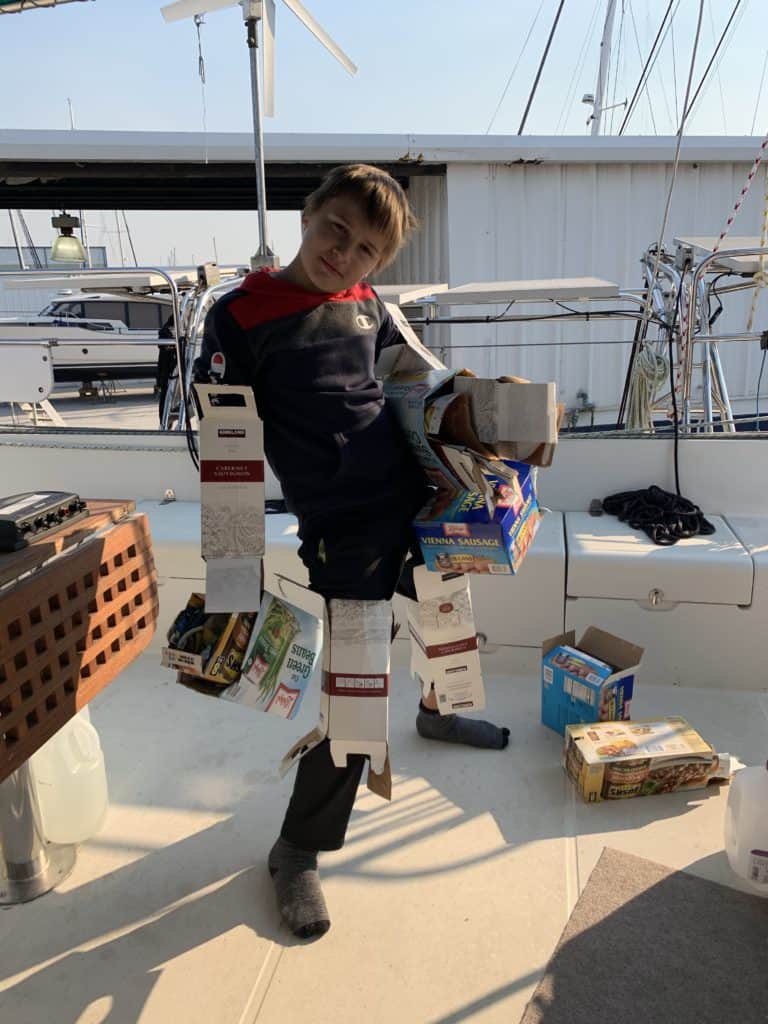
Tip: Make sure you do not accidentally throw out the cardboard box you use as a serving container!
Fresh catch puts all other meal-plans on pause.
When we catch fresh fish, the entire menu planning is placed on hold, and the fresh fish is consumed fairly quickly.
Prior to having a freezer, that meant fish for lunch, dinner and snacks, for two, three days in a row.
If you do have a freezer aboard, the fish can be fileted and cut into steak-size chunks (if it is a larger fish). These can be frozen for a few weeks, or refrigerated for a couple of days.
Use proper fileting knife, it does make a difference, I have tried it both ways. Here is my post with some suggestions: 25 Galley Gear Essentials (We Used All the Time).
Fresh fish should be consumed within a couple of days of refrigeration, due to the higher chance of bacteria developing in the tropical climate. The fridge is never super cold aboard.
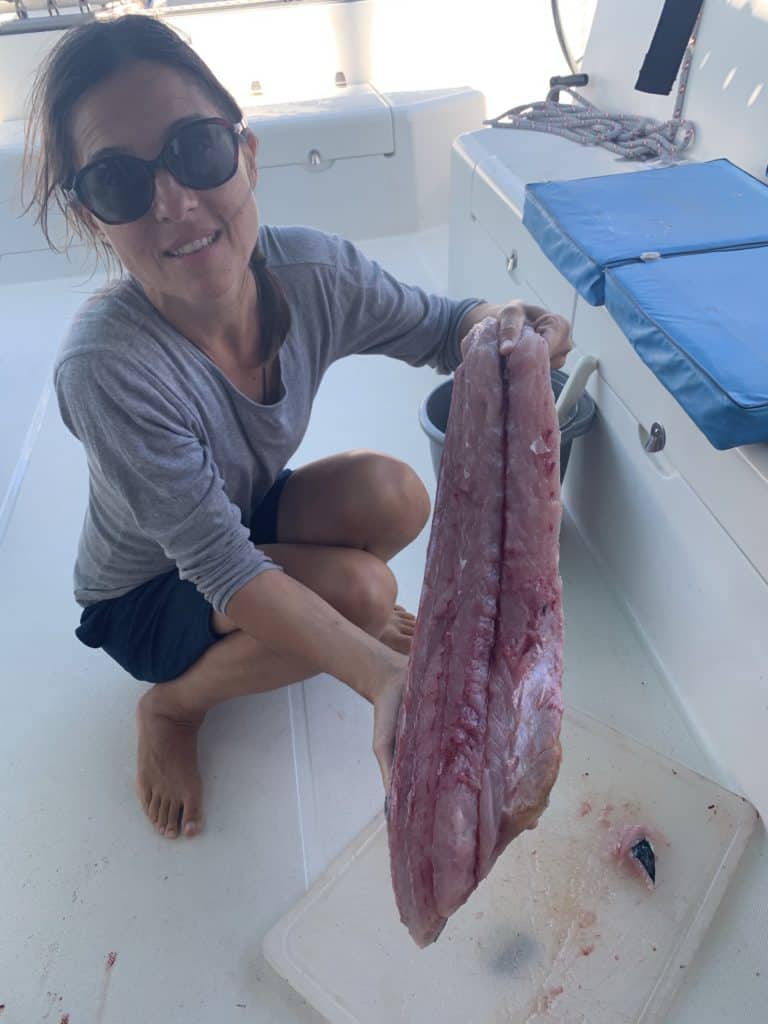
You can even poach the fish and refrigerate for a later use in salads and soups. It will last a bit longer that way.
How to Organize everything in the fridge.
Having a small fridge is a blessing aboard. With less spaces, there is a lot less food lost and wasted in the fridge.
Having three growing kids, means we must cook for five adults aboard. The benefit of that is having that many extra hands to chop, peel and help prepare meals!
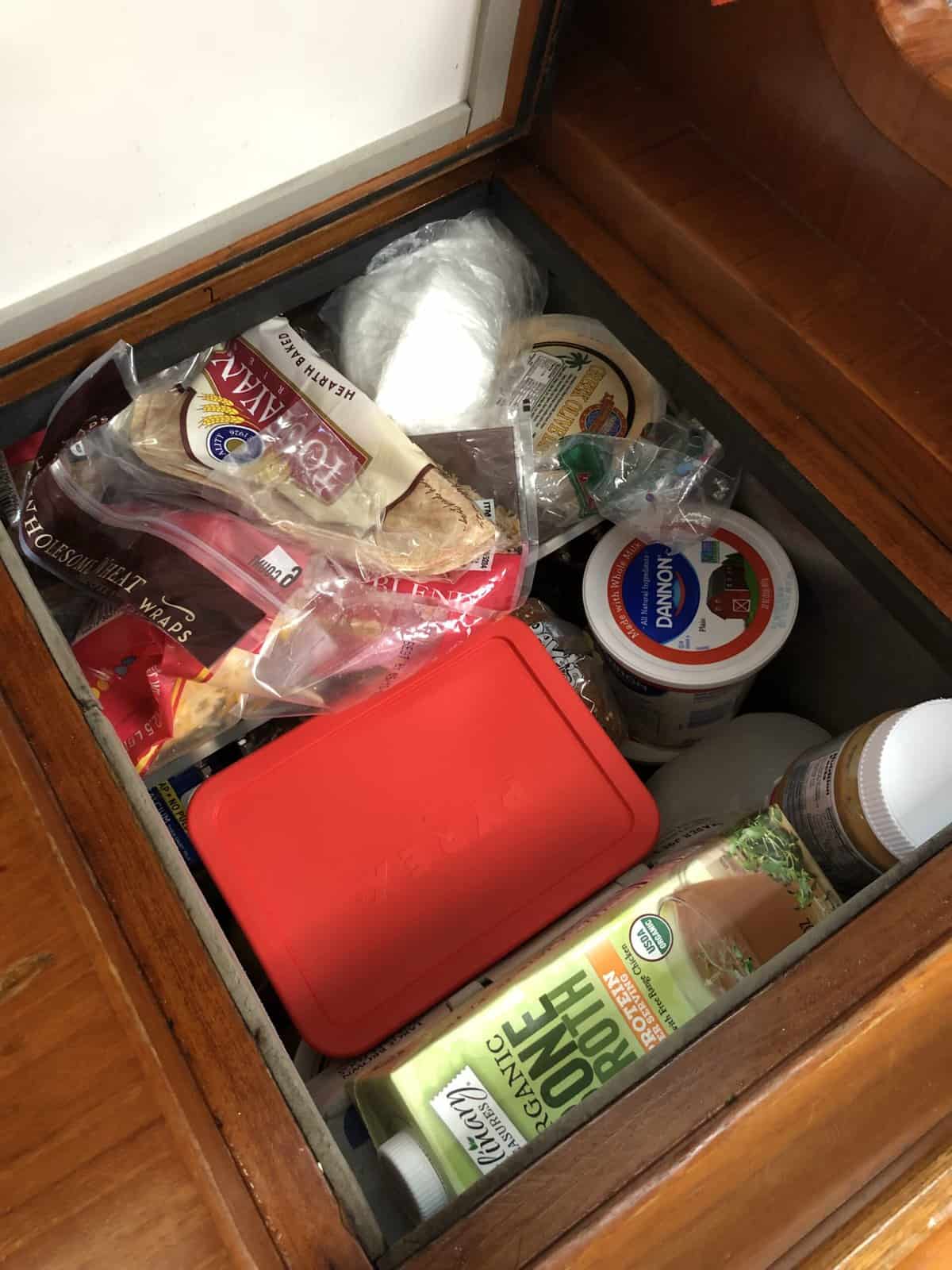
Tip: Sailing with teens means help aboard, when it comes to cooking. Beyond that, cooking can easily be a high school credit too!
Top loading fridge – the bottomless pit.
Our first boat was a smaller monohull with a small fridge, loaded from the top. It does take some getting used to.
I found that organizing foods in lunch boxes helped me find what I needed fast, and it made the best use of the space.
A few lunch boxes, with a handle can serve as storage for cheeses, butter, cut-up snacks, etc.
An added bonus to using these, is minimizing the times to open and close the fridge when it is forever summer all around.
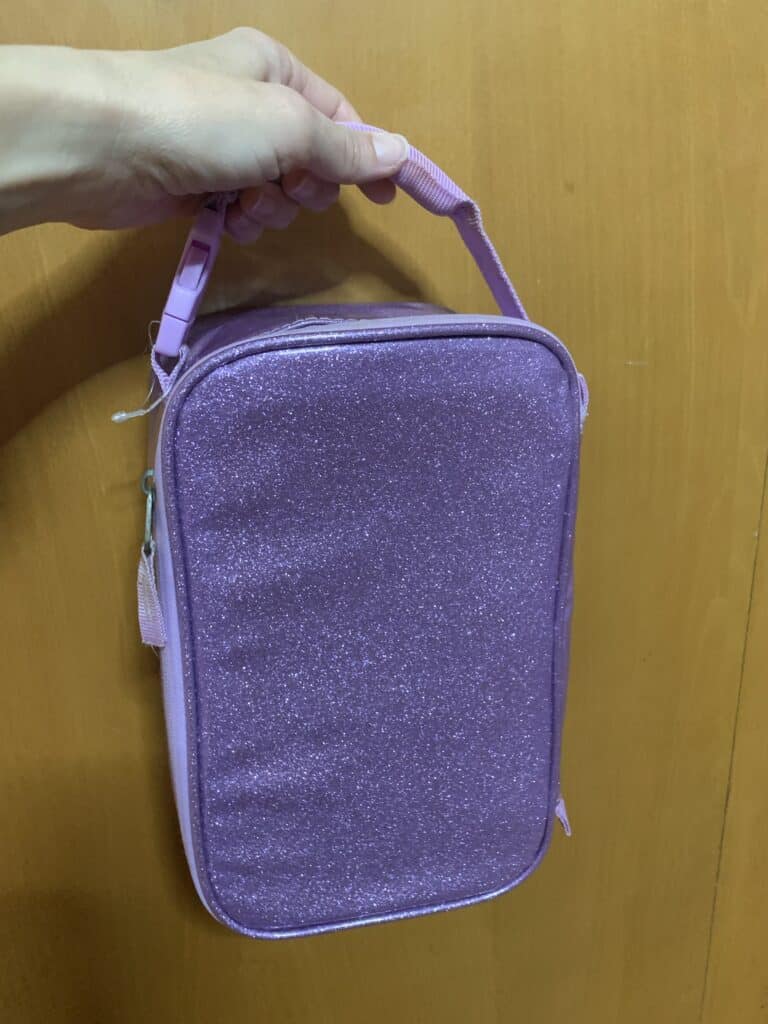
I bought our lunch boxes from Walmart, on sale, for $1 each, so our refrigerated items lived in sparkling pink and purple homes!
Front loading fridge – the front-row priviledged.
Most newer boats and, I believe, all catamarans come with front loading fridge. I have only seen a full-size refrigerator on motor yachts.
The biggest trouble I saw with a front-loading fridge, was the constant moisture inside the fridge. Due to its small size and less than ideal insulation, the shelves in the fridge tend to be constantly wet.
The best solution I found for that issue, was buying a couple of rubber tiles, like the ones they use in some public shower floors.
Mine came from West Marine. They clip together and I lined the bottom of the fridge with them. You can cut them, or just bend up a bit (it’s what I did).
This way, all the water collects below the mat, and the food containers need not swim in a puddle.
Storing frozen foods – totally optional.
A freezer is not a necessity aboard. It is optional.
So, opt for it!
We only had a freezer during the last few months of our cruising life. We did have the free-standing freezer prior to that, but only used it as extra storage for dried foods and additional seating.
Don’t get me wrong, once we were able to have popsicles and ice aboard, no one wanted to go back to the old ways!
Here is our YouTube Episode featuring the big day, when we finally plugged in our freezer aboard!
Just a Perfect Day, on a Boat, in Puerto Rico! (E27)

To be honest, carrying ice-cream from the grocery store, via the dinghy, to the boat, in any tropical place, guarantees you will end up with a sweet puddle in the backpack.
Invest in a good cooler backpack, for your grocery runs, here are some boating bag ideas:
19 Best Boating Bags. Tips How to Use Them.
Write down where everything goes ASAP.
We have gone through excel sheets, hand-written diagrams and plain fridge lists, when it comes to remembering where all that food has been organized.
In the end, what made the most sense, for us, was to keep similar foods together and just check off quantities of cans used once per week.
For example, we kept all of our pasta in one of the boys’ bunk. Right next to the pasta, behind his clothes, lived all of our cans of chopped tomatoes and pesto.
Jellies, honey and peanut butter also shared the same cabinet.
If you happen to forget where those darn canned peaches went, well, they must be in the “Canned fruits, jellies and spreads.” area, rather than in the locker with the greens beans and boxed milk.
Tip: Figure out your cooking habits and organize the food, so it is easy to grab everything needed quickly.
To Summarize
Storing food aboard requires planning. It is not hard, and it teaches good habits, both in meal planning and food appreciation.
Try it with simpler and fewer ingredients first and introduce small additions as you become more used to living aboard.
And be very, very carefuly with ice – once you have it aboard, you can never go back to not using it!
What about getting all the food?
Figuring out how to organize the food aboard is done!
What about buying all the food, in the first place?
You will like our very detailed post about provisioning for the Bahamas. It does not have to be the Bahamas, the general rules and tips are applicable to any longer provisioning plan!
And it comes with free meal plans, too!
Provisioning for Bahamas (With Free Meal Plans – Totally Doable!)
A cute pin that does not rock, break, or leak!
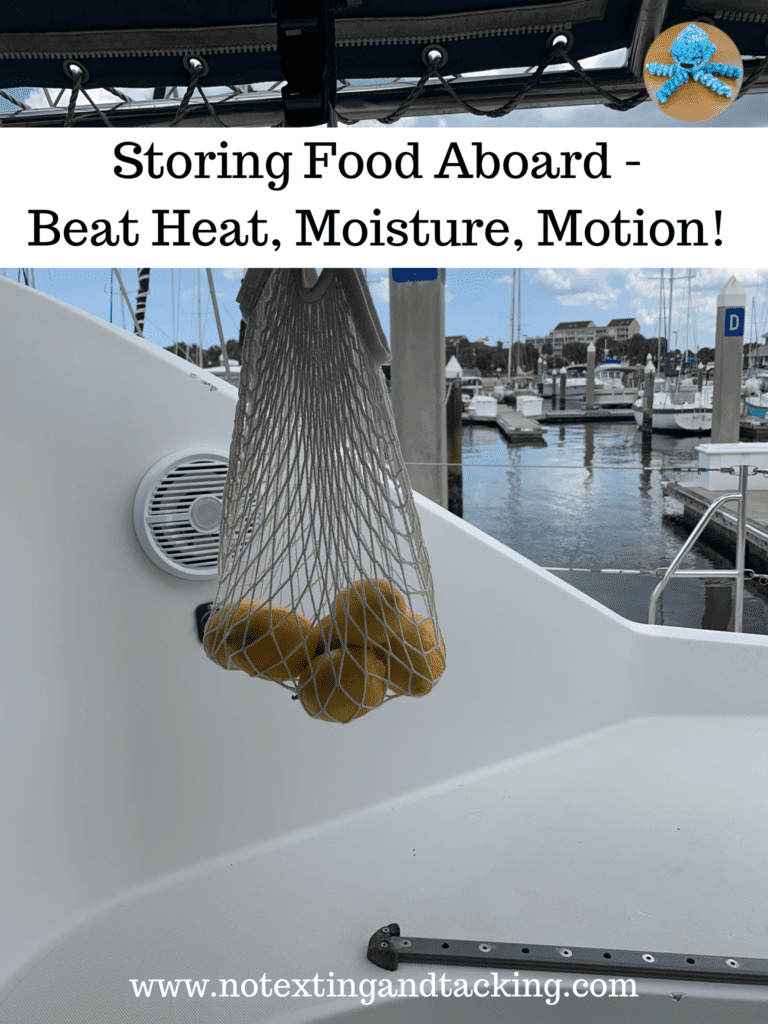
More galley posts:
25 Galley Gear Essentials (We Used All the Time).
Affordable Freezer Aboard (Because Ice Cream Matters).
How to make yoghurt, with a story!
You will also like these useful posts:
My Washing Machine Aboard – Forget Bucket Laundry!
19 Best Boating Bags. Tips How to Use Them.
9 Sailing Outfits for any Season and Reason
Comfortable Sailing Shoes for Every Boating Need
12 Best-Selling Sea and Sailing Costumes
